“IS STUPIDITY A SYMPTOM OF ACUTE RADIATION EXPOSURE TOO?” (read the headline of a blog post I received via e-mail the other day. ) Startled and offended, I marked it with a star and put off reading the article. When I calmed down and skimmed through the post , I found its offensiveness consistent; in short, blaming parents in Fukushima for allowing and the Japanese government for encouraging children to play in a contaminated environment. “Everyone has gone mad!” declared the author of the post, peppering his diatribe with exclamation marks!!
Hmmmmmm….
And then there were these words from a cover letter I received after buying some badges to support the opposition of nuclear power in Fukushima: “Fukushima people are silent. They do not have the courage to express their concerns regarding the future use of nuclear power…..The true defeatists are those who remain in Fukushima, who say they have no choice other than to make their living in the contaminated areas….They are beaten. Constant radiation and relentless social pressure has (sic) clearly made many Fukushimans tired and passive.”
Really? Fukushima residents are “stupid”? “beaten”? “passive”? Robbed of their wits and their voices by the effects of radiation and social pressure? Isn’t it only too easy to be judgmental from the outside, and to mistakenly attribute one’s own voice and heartfelt conviction to others who are deemed “voiceless”? Other troubling phrases and declamations embedded in the blog posts and facebook updates I scroll through regularly had been nagging at me, and when my geographer friend Yukari invited me on a day trip to Fukushima City, I jumped at the chance. “Hah!” I thought. “The whole truth won’t be revealed in a day, but at least I’ll have had a peek at things from the inside.”
And so I set off, leaving Shinjuku at 6:58 in the morning (trains run precisely to the minute here) meeting up with Yukari in Oomiya, the very cool station where several different bullet trains converge briefly before gliding off again to their respective destinations. We rode “Yamabiko”, named after a Japanese “echoing spirit” that’s heard but not seen; try to touch it, the legend says, and you feel something like molasses on your hand.
After we had devoured our boxed breakfasts and enjoyed an hour or so of gossip on the train, Yamabiko slid smoothly into the Fukushima station, and we were ready for business. Yukari’s two geographer friends joined us at the station and we squeezed into a taxi, directing the driver to the address of the Fukushima Midwives Association ‘s main office in the Watari district.
Why exactly were three geography professors keen on interviewing the president of a midwives association? Well, having assisted in translating Yukari’s papers over the course of fifteen years, I can tell you. Geography is more than just countries, capitals, landscapes, and vegetable crops. It is subdivided into two related fields–human geography and physical geography–with geographers focusing on one or the other, or (not uncommonly) on the interaction between the two. One of the best examples of this would be my daughter’s college in Bar Harbor, Maine, which offers only one degree, in “Human Ecology”, or the relationship between man and his environment. All students of the College of the Atlantic are geographers by the time they graduate, and the geography professors packed into the taxi in Fukushima were human ecologists as well: prepared to ask hard questions about raising children in a contaminated environment. I was there as an interested third party, and as the official photo publicist.
Our driver guided the taxi through a maze of narrow residential streets quite similar to my own neighborhood in Hadano, and left us off at an unobtrusive little white apartment building. Up a steep concrete staircase, and before we could ring the bell, the door few open. “Well, here you are!” beamed a small grandmotherly-type woman with fuschia-colored lipstick and a lovely floral patterned jacket and skirt. I mention this because my image of a “midwife” is of unshaven legs, Birkinstock sandals, and long flowing hair. Certainly the midwives who attended me at my two births had done nothing to dispel that image. Ishida Tokiko-san, President of the Fukushima Midwives Association, was dressed fancy to receive visitors, and she welcomed us into her office with a warm smile.
Her “office” was nothing more than a one room Japanese-style apartment, with tiny kitchen and bathroom attached, yet it was light and pleasant; the main centerpiece was a good-sized low table (we call them “coffee tables” in the US, but they’re used for serious eating in Asian countries) with cushions rather than chairs. The decor was a large white banner with messages of love and encouragement sent from America. “You must be surprised at this tiny place,” said Ishida-san cheerfully, “…but imagine how difficult it was before we found a place to set up headquarters after the quake!” …..And that was the beginning of a four hour story session, as each question posed by one of the three geographers led naturally to an incident that begged to be related.
Here are bits and pieces of what we learned:
It was chaos for mothers with babies and small children when the quake occurred, followed by the tsunami and the explosions at Fukushima Daiichi nuclear power plant. Those who survived but lost their homes fled to public evacuation centers, sleeping on gymnasium floors along with other families and scores of elderly citizens. But communal living was stressful; babies howled uncontrollably and needed to be nursed, and mothers felt the strain of trying to “keep the peace” so that the family on the futons next to them could sleep. Public officials did their best to move families with babies into the only available housing in the prefecture: civil servants’ office buildings and rooms at Japanese-style inns located far west of Hamadori, the area of Fukushima hardest hit by the plume of radioactivity. This was only a temporary solution, since the office buildings had no utilities or furnishings, and rooms at the inns were cramped quarters for extended families. Eventually, families moved again, some moving multiple times before finding something that functioned as “home”.
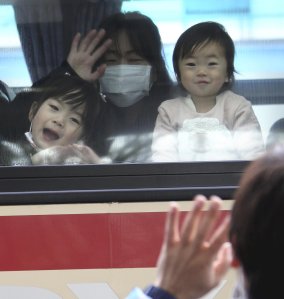
Many mothers fled with small children to live with relatives in less-contaminated parts of the prefecture, leaving fathers behind to “keep house”.
In short, during the first few months after the quake before temporary housing was completed, mothers and their small children were scattered, scrambling to find safety, privacy and protection from the elements. Some lived in cars, some in tents, and some with relatives in other cities or prefectures; some went back to stick it out in partially-damaged houses and some accepted offers of temporary housing from far-away parts of the country. And as the first temporary housing complexes were completed, some families moved into the tidy little box-like apartments to begin new lives in artificially-created communities.
During those first few chaotic months, Ishida-san and her staff worked tirelessly (though I’m sure they were tired to the point of collapse) to make sure that new mothers received both practical and emotional assistance and that pregnant women received adequate care. Since town registers were in the process of being re-created, midwives had no other recourse but to take their own population census, going door-to-door looking for pregnant women and mothers with small children. Gas was scarce, so they walked or bicycled about their neighborhoods armed with diapers and baby wipes. Needless to say, their diaper crusade was a volunteer effort until some months later, when money began to trickle down from various places. I was humbled and impressed to learn that in the first year, the midwives of Fukushima were important connecters: they scouted out young families in apartments and reported their residence to town officials for the registry; conversely, they also received information on available apartments from town officials and brought the news directly to families in need of shelter.
In the fall of 2011, an aid group in Tokyo stepped in to create a unique and much-appreciated option for pregnant women and young mothers: a center for rest and recuperation after birth, located in relatively safe (everything related to “safety” is relative here) Aizu district of Fukushima. The “Satogaeri”, or “Return to the Hometown” project was popular from the start, providing a physical and emotional shelter for mothers. Yet after an all-too-brief two week stay at the safe and welcoming center for new mothers, women returned to their previous living arrangements to face the challenges of motherhood in post-3/11 Fukushima.
At this point, Ishida-san’s assistant, Sanpei-san, told us of her own experiences raising her one-year-old son during the first year after the quake. Those were the days when children did not play outside. When Yuri and her son did leave the house, she could not use the baby stroller or let him walk, as the child would be too close to the ground (where radiation levels were highest). She carried her son everywhere, no matter how far, and returned to the house exhausted. Coming home meant brushing off outside dirt (again, dirt meant radioactive particles) , and washing and hanging (inside) more loads of clothes. What did she do inside with her toddler all day long? ” We read books. I tried baby massage. I fought with my husband.” Many women, she said, took their stress out on their children. Husbands and wives fought. Mother-in-laws and their daughter-in-laws fought. Friends drifted apart. Some individuals owned multiple geiger counters and obsessively measured the radiation level of their houses and yards which often increased anxiety, rather than relieving their fears. Everyone was vulnerable to criticism, vulnerable to unfounded rumors, and struggling with fear and uncertainty.
Throughout this difficult time, Ishida-san and her colleagues increased their efforts to rally fellow midwives and organize services to ease the emotional needs of mothers who had chosen to live in Fukushima prefecture. The Midwives Association set up a telephone support line, which was flooded with calls on a daily basis. They also started a “salon” where mothers could bring their small children to meet regularly and interact in a supportive environment, free from criticism and negativity. Midwives paid home visits to new mothers and helped them through the first stages of breast-feeding. They received samples of breast milk from nursing mothers and sent it off to labs to test its radiation level. They got out their calculators and helped nervous mothers figure out their daily exposure to low-level radiation. Rather than giving advice, the midwives provided practical assistance, emotional support, and a collective listening ear.
And now, let’s get to the meat of this post. What I really wanted to know and really hated to ask was, Why were so many mothers still living in the Watari area, which has been the focus of negative publicity for the past two years? “Save the children of Watari!” has been the rallying cry of NGOs and citizens’ action groups who believe that the Japanese government is guilty of criminal neglect for not providing evacuation money to the citizens of this district.
The district known as Watari is 60 kilometers from the Daiichi nuclear power plant, well outside of the designated evacuation zone, and the government has chosen to tackle the issue of low-level radiation via ongoing decontamination rather than providing financial support for those who choose to leave. Opponents of the government’s decision, however, claim that the radiation levels remain alarmingly high and that families should not be raising children there. I wanted to know how many mothers still wished to leave the Watari district, but were unable to find financial support. I wanted to know if mothers were simply stuck there, or if they had made a choice to remain despite the negative publicity.
Ishida-san answered my questions bluntly. “Hmm.” she said. “Wanting to leave, but don’t have financial means? No, we get no calls like that here at the center. That’s not a factor at all these days. Those who live here have made their choice.”
Oh. Well, then. I guess “Save the Children!” is a campaign without a cause. Or a cause that has run its course and is no longer relevant? Or perhaps those families waiting to get out are still too paranoid or ashamed to go public with their appeal?
According to Ishida-san, the “Save Watari Kids!” organization has done more harm than good in Fukushima by urging residents to flee from their hometown. “Women had just begun to calm down and pick up their lives again and feel positive when people from outside Fukushima Prefecture came in and shook things up. Mothers who had begun to make progress in coping with their anxieties began doubting again and fell into depression and paranoia.” Until this point, Ishida-san had spoken matter-of-factly, but here she looked to be holding back tears. I was riveted to her face as she spoke; the issue was undoubtedly more complicated than she intimated, but certainly she was speaking a part of the truth, and speaking it with certainty.
Another part of the truth: internet links to NGOs supporting the evacuation of the
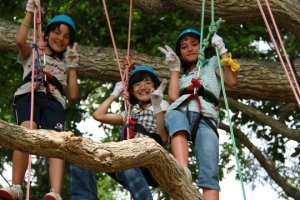
These children enjoyed an extended vacation in Hokkaido, thanks to a charity fund-raising website called “Global Giving”.
Watari district show that many residents responded positively to the NGO’s efforts to force the central government to enforce stricter safety standards and provide financial support to families wishing to leave. Many residents appreciated the fact that outsiders were able to increase awareness of their situation throughout the country, and even abroad. And many NGO-sponsored projects to provide children with “radiation-free vacations” in the countryside have proved popular. I have met people involved in the “Save Watari Children” projects (mostly in Tokyo, where they pass out leaflets promoting their activities), and they are good people.
Well-intentioned people also produced the “No Nukes in Fukushima!” badges and wrote the cover letter that gave me pause this morning. What can be said, then, about their declarations that Fukushima residents are “beaten” and defeated? That they are too passive, and unable to take steps to control their own destinies?
Uuummm….I don’t want to touch that issue with a ten foot pole, a hundred foot pole, or any kind of pole at all. No-one outside the prefecture has the right to make that kind of judgement, and even Fukushima natives had better choose their words carefully. Ishida-san did have something to say about the character of women in Northern Japan, however, and after a few decades of delivering babies and caring for their mothers, she’s probably qualified to speak out. Here’s her assessment (translated as accurately as possible by myself) :
“Women of Northern Japan do not express their opinions easily. They often do not have their own opinions, because they are not aware that this is acceptable. They do not know where they stand, because they have not had to take many stands. They are taught to follow, to grit their teeth and bear what’s unpleasant, and to persevere in the face of rough circumstances rather than to affect change. This makes them vulnerable to criticism, to pressure from family, to propaganda campaigns, and to anxiety stemming from uncertainty and indecision. Women are unable to decide anything on their own, so they turn to us for help. We listen, we do not criticize or advise, and we teach them gently how to make decisions. We work with them, rather than telling them.”
Wonderful, right? A midwife service that not only delivers babies, but teaches decision-making and inner strength! …but does it work?
Sadly enough, Ishida-san admitted that women in Northern Japan are emotionally weaker, rather than stronger, since the Great East Japan Earthquake, despite the best efforts of the Midwives’ Association. And it is a good-sized network: 114 registered midwives serve the Fukushima prefecture, not counting those with licenses who work independently. Their efforts, however, are not enough to stem the tide of anxiety and fear stemming from the post-meltdown environmental contamination. I realized that since the quake, midwives have been serving as counselors and therapists (Japan has a dearth of both) as well as baby-whisperers, and again was both humbled and impressed.
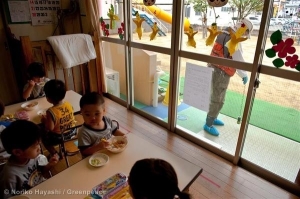
You can’t be too careful. Little ones still spend most of the day indoors at many nursery schools in Fukushima. Outside, radiation levels are being checked (photo courtesy of Greenpeace).
Ishida-san and her assistant Yuri-san spoke of their patients with understanding and sympathy, rather than pity. Since they live in the same district of Fukushima as their patients, they share the same challenges, and they also have chosen to take precautions against nuclear radiation rather than leave their homes and break up their family units. They test their food. They hang laundry inside. They shake dirt off on the doorstep. They clean the outside of their houses with power hoses (courtesy of the central government). They check radiation levels around their homes on a daily basis. They try to stay informed, though this is not easy to do as they are constantly bombarded with conflicting information. They believe that radiation levels have gone down significantly, and that they can build a new life for themselves and their children without leaving Fukushima.
Is this wise? Have folks’ brains been, as some bloggers like to intimate, addled by radiation poisoning? Well, that is none of our business, is it? We all have the right to decide our own course, and as Ishida-san firmly stated, health is not just about physical well-being. She and Sanpei-san both believe that those who have chosen to stay in the Watari district have made valid decisions based on ties to their family, work commitments, and living arrangements, and that these factors are important for their emotional health. Ishida-san and her colleagues believe that their job as midwives is not to judge, but to support women, and to encourage them to think for themselves and decide their own futures. The Fukushima midwives teach by example, dealing with hardship calmly and providing steady encouragement and a dose of old-fashioned common sense. Isn’t that what’s needed, more than “saving”, when all is said and done? Perseverance and endurance doesn’t have to mean weakness.
As I mentioned at the onset, our visit at the main office of the Midwives Association lasted a full four hours. Finally, realizing that Ishida-san must be hungry (we ourselves were starving), we excused ourselves and grabbed a taxi back to the Fukushima Station. It was a beautiful day, flowers were blooming, high school girls were hanging out in short uniform skirts, and Main Street looked like any ordinary rural Japanese city center except for the dearth of people. Too many taxis hanging out, too few shoppers lining the sidewalk, and too few tourists buying souvenirs at the station shops. Yukari and I bought some sweet little dumplings to take home, and boarded the super-sleek bullet train headed back to Tokyo, equipped with both food for literal consumption and food for thought.
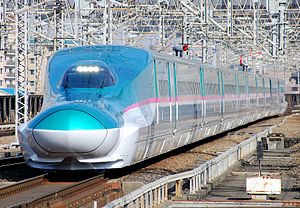
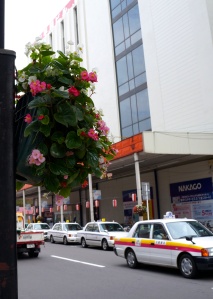
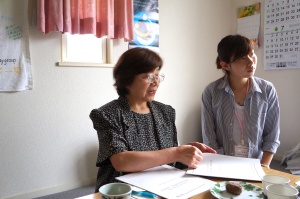
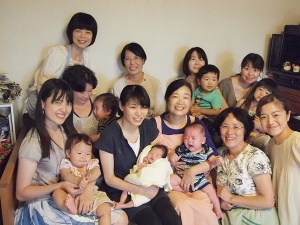
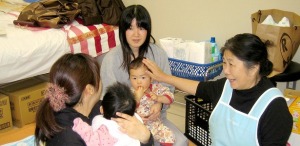


So, people are just getting on with their lives.
Yes, they’re getting on with their lives. But everything is more complicated than it was before, so it’s not like “picking up where things left off”.
Nice piece Ruthie! Full of food for thought indeed….
Deep and thought provoking account Ruthie. Thank you for sharing.
I’m so sorry I didn’t know about your blog last year when I lived in Hadano on a grant! I hope you continue to post as your blog is excellent.